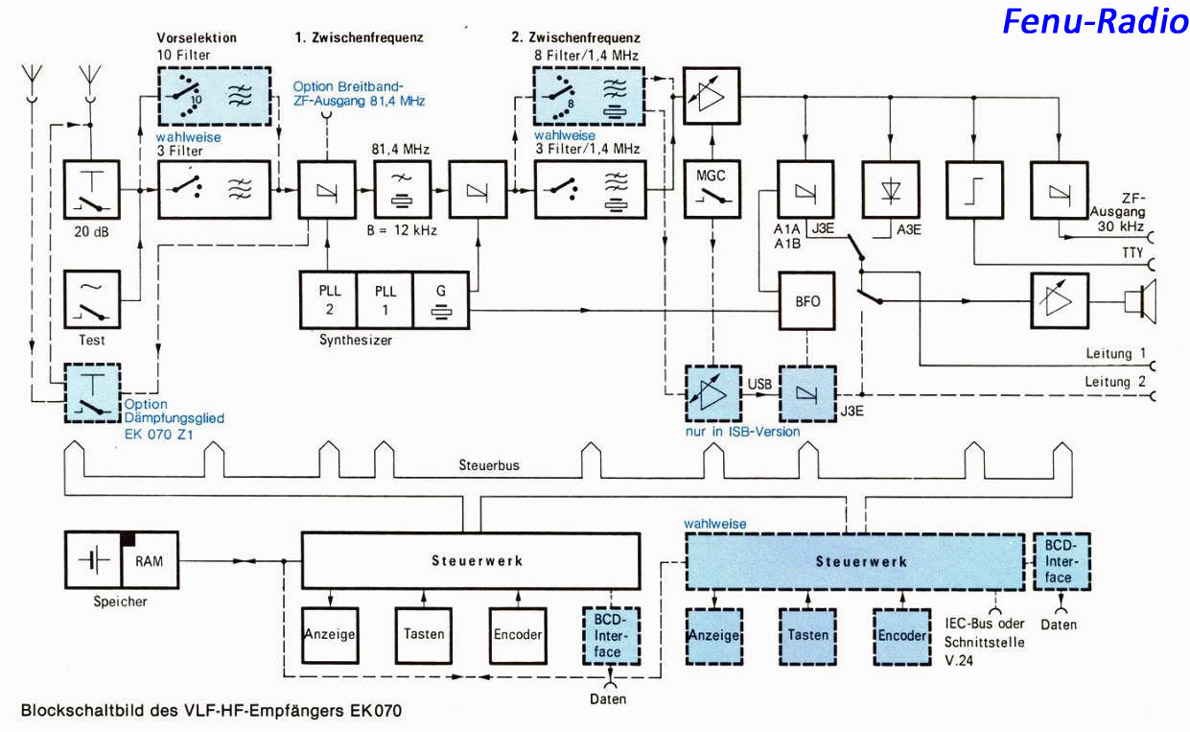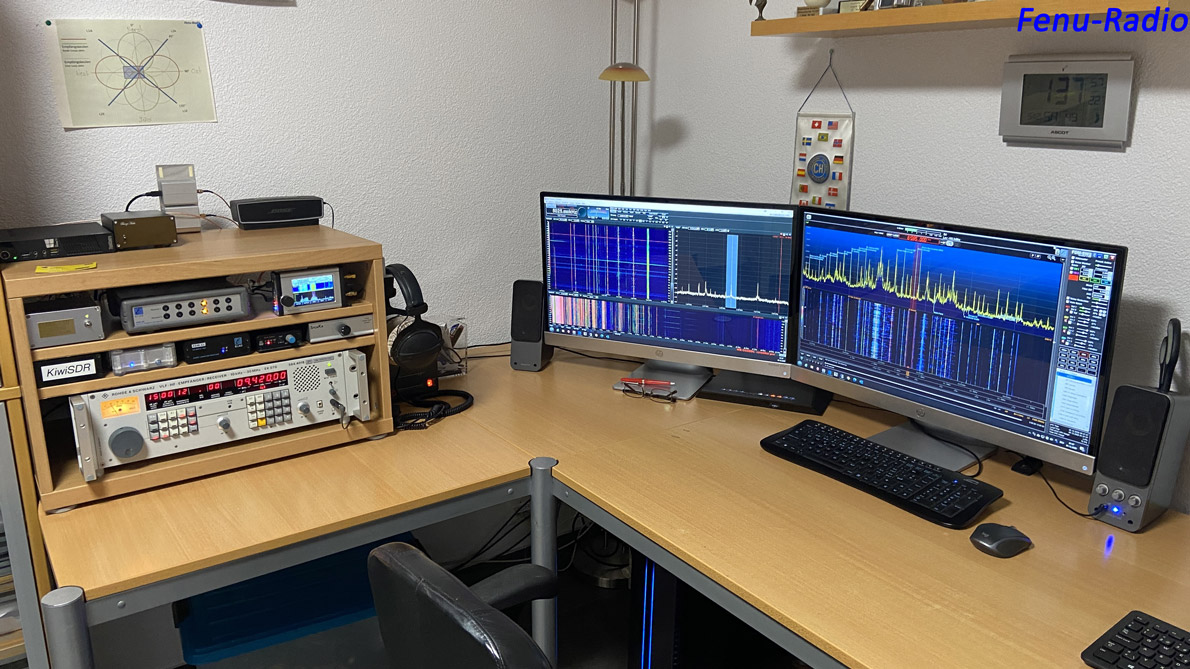|
Rohde & Schwarz EK070
2020 was a memorable year in many ways. The Covid-19 virus is still keeping us busy. Fortunately, I've been spared this until now. Despite all precautionary measures to protect against any viruses, I was attacked again by a well-known virus. The 19 "virus! This virus does not actually make you sick, but should rather be described as an addiction that spreads among radio enthusiasts, radio amateurs and SWLs. I thought I was finally rid of this addiction. But as a Rohde & Schwarz myself EK070 was offered at a very fair price, the old addiction flared up again. I have never owned a Rohde & Schwarz receiver. So all concerns about hidden defects were thrown overboard and the EK070 passed into my possession. Because I have the I have known the previous owner for several years and he is a trustworthy person, it was not difficult for me to drive almost 400km to pick up the EK070, so you also have the opportunity to test the device on site. The EK070 is a commercial receiver that was distributed worldwide to government agencies such as embassies, eavesdropping services, the military and coastal radio stations. After being phased out, many of these recipients found their way to private individuals. Most of them were radio amateurs or SWLs. Like many other commercial receivers, the EK070 has almost no tools built in to improve reception. Almost everything that is important for the SWL is missing. Noise blankers, pass band tuning, notch filters, noise filters, etc. are not available. Only the BFO function can be used in the SSB operating mode as a quasi passband tuning to suppress interferers.
This EK070 came from a
government facility and was probably used for automated FSK
reception. The coveted 3.1KHz filters for USB and LSB are installed
for voice transmissions in SSB. For AM only the 12KHz roofing filter
is available, which is of course much too wide. The previous owner,
who is a radio amateur and electronics engineer, installed an
additional original 6KHz filter on the EK070 after the 12KHz filter,
so that the receiver was suitable for AM. That kills two birds with
one stone. Full AM suitability and the cascading of the 6 and 12 kHz
filters means that reception is even more selective. The EK070 is a heavyweight. The very robustly built receiver weighs a whole 23kg. It has a modular structure, which means that the electronics are built into modules. Practical for professional use. If a module fails, it can simply be replaced with an identical one. This is rather bad for the hobby company. If something breaks, it will be difficult to repair the device. This EK070 also has the preselector module built in, which has an effect on excellent large signal resistance. The front panel is the real eye-catcher. The EK070 has a white painted front, which is typical for Rohde & Schwarz receivers. With the red LED display and the robust pushbuttons with a crisp pressure point, the EK070 simply looks great! The large tuning button on the left literally screams to be touched. If you turn this large gray tuning knob for the first time, you will be amazed at its feel. It is not completely free running, it has a fine magnetic detent. Then there is the ingenious flywheel effect. A little push and the tuning knob turns and turns ... Simply a wonderful feeling this frequency tuning.
Blockdiagram from EK070
Working with the EK070 After switching on, the EK070 needs a few minutes so that the quartz oven can heat up to the required temperature so that the frequency remains stable. You can quickly learn to operate the receiver using the operating manual supplied. The frequency entry is very easy to do. as an example we want to set 6085kHz. Entry: 0608500. After the last digit has been entered, the EK070 switches to the frequency. The designation for the operating modes takes getting used to, but is the case with many older and all commercial receivers. Here is the solution:
CW = A1 To program the 30 memories, press "STO", then enter the desired memory with the digits, e.g. 15, and that's it. The frequency, operating mode and bandwidth filter are stored in memory 15. Calling up a memory is just as easy. Press "RCL" and enter the desired memory. With the - / + keys in the number field you can switch back and forth from memory to memory. The BFO offset, mainly for CW, is also entered using the keyboard. Press "BFO" e.g. Enter 07 for the pitch 700Hz. The frequency tuning is done with the wonderfully running tuning button that is magnetically locked. Set the step size and start turning. The magnetic detent enables fast and precise tuning of the frequency. These are a few brief examples of the operation. As with many other commercial receivers, the audio is just great! The audio of the EK070 in AM sounds almost like the audio of the Winradio G33DDC in AM-Synchron. To get the best possible audio, it takes some manual work. If you focus on a weakly incident transmitter, you switch the gain control to "MGC" (Manual Gain Control). This allows the gain to be adjusted. In this way, the SNR (Signal / Noise Ratio) can be set to the best value. The sound in SBB with the 3.1kHz filters is outstanding! On densely populated amateur radio bands, they are a bit too wide. Sure, these filters are designed for commercial use. The frequencies on which the professionals work are never as busy as the amateur bands. One thing that bothers the EK070 a little bit is the tuning noise. It appears that the control pulses from the electronics are induced into the audio. When the volume is set to a lower level, every key press can be heard in the headphones or through the loudspeaker. It becomes very audible when the tuning knob is turned quickly. Then a very clear "hum" can be heard. The EK070 integrated into my receiving station
The EK070 in Action.
Conclusion: The Rohde & Schwarz EK070 is an excellent VLF-HF receiver. He is still coveted and sought after. A milestone in receiver construction! posted: 20.12.2020
|

.jpg)

.jpg)

